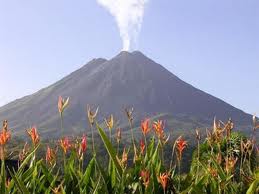Hello, today we have started a new unit. It is called climate and living things. Here we go:
First, I will write the definition of atmosphere and describe the definition of it's layers and their most important characteristics:
 ·Atmosphere: is the layer of gases that surrounds the Earth and makes life possible on the planet.
·Troposphere: It is the closest layer to the Earth, less than 10 km high. It is essential for life in Earth. It is composed of air and water vapour and it's where snow, rain, etc. occur
·Stratosphere: 10-50 km altitude. Temperatures starts to rise from 20 km upwards due to ozone, a gas that stops harmful ultraviolet radiation from the Sun.
·Mesosphere: 50-80 km altitude. Temperatures drop quickly, falling as low as -90ºC.
·Thermosphere: 80-500 km altitude. Temperatures can reach over 1000ºC.
·Exosphere: outer limit of the atmosphere, wich begins at an altitude of 500 km.
·Atmosphere: is the layer of gases that surrounds the Earth and makes life possible on the planet.
·Troposphere: It is the closest layer to the Earth, less than 10 km high. It is essential for life in Earth. It is composed of air and water vapour and it's where snow, rain, etc. occur
·Stratosphere: 10-50 km altitude. Temperatures starts to rise from 20 km upwards due to ozone, a gas that stops harmful ultraviolet radiation from the Sun.
·Mesosphere: 50-80 km altitude. Temperatures drop quickly, falling as low as -90ºC.
·Thermosphere: 80-500 km altitude. Temperatures can reach over 1000ºC.
·Exosphere: outer limit of the atmosphere, wich begins at an altitude of 500 km.
Now I will explain the main differences between weather and climate and describe what is climatology.
 ·Weather: It is a result of atmospheric conditions at a certain place and time.
·Weather: It is a result of atmospheric conditions at a certain place and time.
 ·Climate: It is the result of average atmospheric conditions in a certain region over a long period of time.
·Climate: It is the result of average atmospheric conditions in a certain region over a long period of time.
·Climatology: It is the science of climate, the study of the climatic elements and the factors that affect it.
The elements of climate:
·Temperature: It is the amount of heat in the air. We measure it with a termometer and express it in degrees centigrade (ºC).
·Precipitation: It is water from the atmosphere that falls onto the Earth's surface in the form of snow, rain, hail and sleet.
·Atmospheric pressure: It is the pressure that the atmosphere's weight exerts on the Earth's surface.
·Wind: It is air that moves from areas of high pressure to areas of low pressure.
Ok, now I will writte about the different Earth's climates.
Tropical or hot climate
·Equatorial climate: Temperatures are high throughout the year. the mean annual temperature is over 25ºC. Precipitations are abundant all over the year, over 1500 mm annually. There is no dry season.
·Humid tropical climate: Temperatures are high throughout the year. The mean annual temperature is over 20ºC. Precipitations are abundant, although less than 1500 mm annually. There are two seasons, the dry one in winter and the wet season in summer. A variation of the humid tropical climate is the monsoon climate wich has torrential rainfall from June to September.
·Dry tropical climate: Temperatures are mild in winter and hot in summer. The annual mean temperature is over 18ºC. Precipitations are scarce, although more than 250 mm annually.
·Hot desert climate: Temperatures are high. The mean annual temperature is over 20ºC. There is a pronounced difference between day and night temperatures. Precipitations are very rare at any time of the year, less than 250 mm annually.
Cold climates
·Polar climate: Temperatures are very low, not exceeding 0ºC except in some places in summer. Precipitation is very rare, less than 250 mm annually, usually snow.
·Alpine climate: Temperatures fall with altitude. Winters are cold and summers cool. Precipitation increases with altitude.
Temperate climates
·Mediterranean climate: Temperatures are mild in winter and hot in summer.
 Two hours later a big storm was coming and Jenny was alone, she tried to phone everybody she knew but no one picked up the phone. She was scared. Suddenly, strange sounds started and she went to see where they were coming from. Then she went out and she saw big ice pieces falling down from the sky. She tried to dodge them. She ran under a bench but it broke. She ran with all the energy she had to the canopy but, there wasn't one!! so she ran home.While she was running a big hail stone hit her on the head.
Two hours later a big storm was coming and Jenny was alone, she tried to phone everybody she knew but no one picked up the phone. She was scared. Suddenly, strange sounds started and she went to see where they were coming from. Then she went out and she saw big ice pieces falling down from the sky. She tried to dodge them. She ran under a bench but it broke. She ran with all the energy she had to the canopy but, there wasn't one!! so she ran home.While she was running a big hail stone hit her on the head.








